How to Give a Cat a Flea Bath: Tips and Tricks for a Stress-Free Experience
If you’re reading this, chances are you’re facing the itchy dilemma of fleas making themselves at home on your precious kitty. And now, you’re pondering the daunting task of a flea bath, right?
I get it. The thought of bathing a cat can send shivers down the spine of even the most seasoned cat parents. After all, our feline friends aren’t exactly known for their love of water.
But here’s the good news: tackling those pesky fleas doesn’t have to be a nightmare—for you or your fur baby. You can turn this flea-busting mission into a chill spa day that your cat might not exactly love (let’s be real) but certainly won’t dread. Sounds good? That’s what we’re aiming for!
This guide is all about making the flea bath experience as stress-free as possible. We’re going to chat about how to give a cat a flea bath, how to prep, what to do during the bath, and how to wrap things up without turning your bathroom into a splash zone.
Plus, I’ll share some neat tricks on choosing the right flea shampoo and mastering the process of drying your cat without causing a fuss.
How to Give a Cat a Flea Bath – Pre-Bath Preparation
Before we jump into the nitty-gritty of flea-bathing your whiskered friend, let’s chat about getting all your ducks (or should I say cats?) in a row. Preparing for a flea bath is like prepping for a tiny, furry spa day—except the guest of honor might be a tad more reluctant.
But don’t worry, with a sprinkle of patience and a dash of preparation, we’ll make this as smooth as a cat’s whisker.
Understanding Your Cat’s Temperament
Understanding your cat’s temperament is a bit like being a detective in your own home, trying to decode the mysteries of your furry friend’s mood swings and behaviors.
Cats, much like people, have their own personalities and quirks, and getting a read on these can make all the difference when it comes to tasks like giving them a flea bath.
Ever noticed how some cats are the life of the party, ready to explore and play at a moment’s notice, while others might prefer the quiet life, observing the world from the safety of their favorite hiding spot? That’s temperament at play.
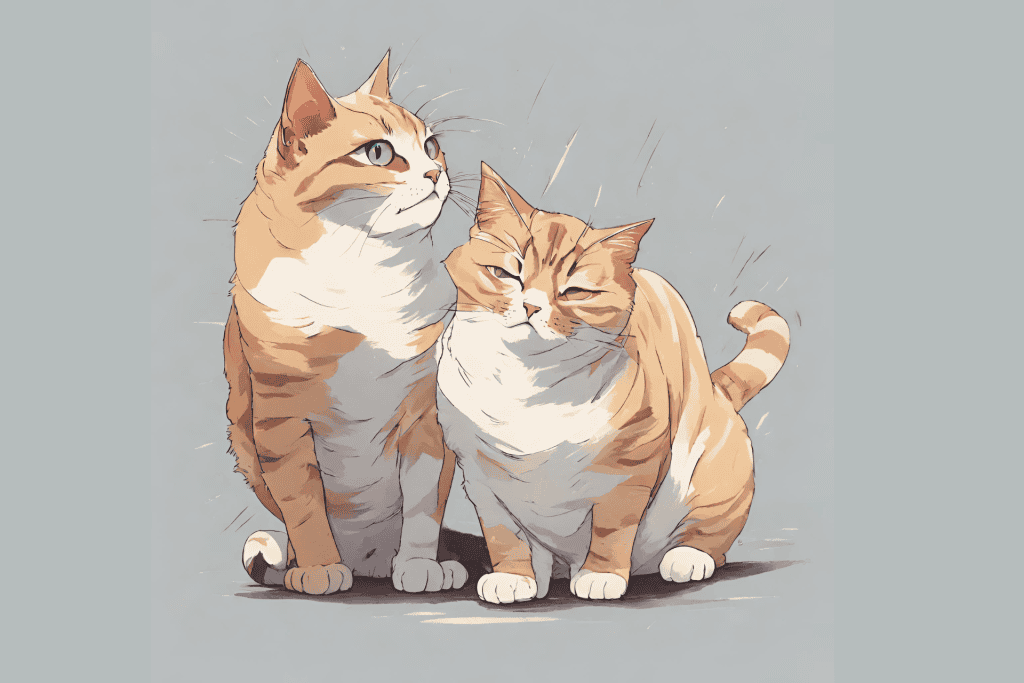
Recognizing indications of stress in your cat is essential. It’s all about observing the little things. Is your cat hiding more than usual, or maybe they’re vocalizing their displeasure a little too often? These are clues.
Watching for these signs can help you understand when your cat might not be feeling their best. It’s like they’re trying to tell us something if only we’re willing to listen.
And when it comes to calming your cat before a potentially stressful event like a bath, it’s about speaking their language. Have you tried using a calming pheromone diffuser or spray?
It can work wonders to soothe their nerves. Or maybe find that special spot where they love to be petted? Remember, it’s all about creating a sense of safety and security for them.
What essential items do you need for a cat flea bath?
You’ll want to gather a little toolkit to make the experience as smooth as butter for both you and your furry friend.
First up, you’ll need the star of the show: flea shampoo that’s specifically designed for cats. It’s like picking out the perfect shampoo for your hair type, but in this case, it’s all about making sure it’s safe and effective for your cat’s skin and fur, and, of course, lethal for fleas.
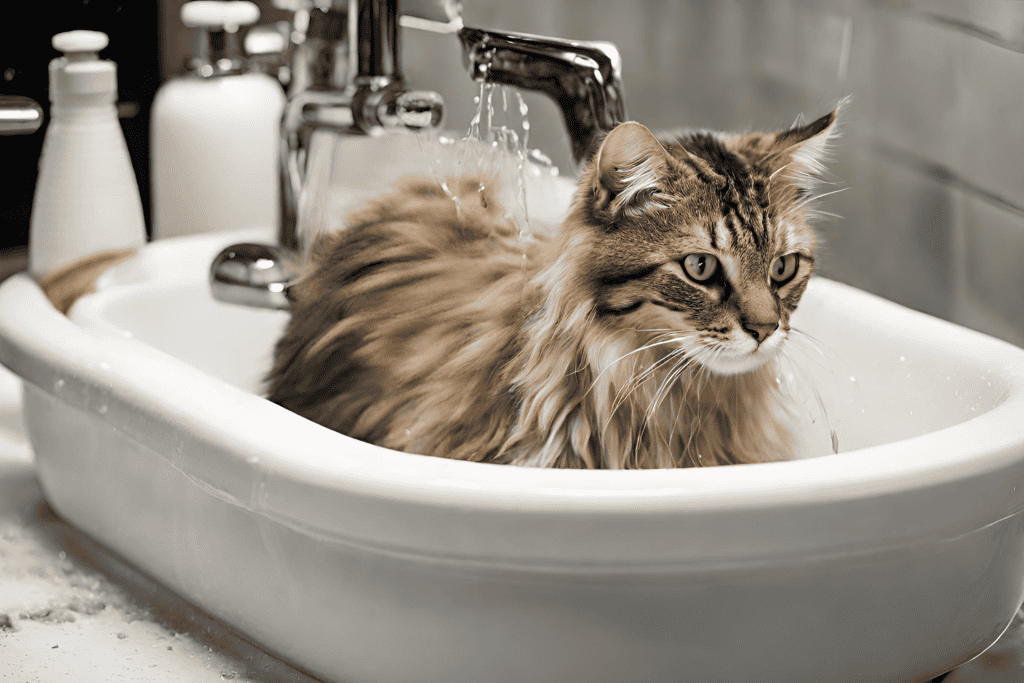
Next, think about where this bathing extravaganza is going to take place. A sink or a small tub can be your stage. Add a non-slip mat to the mix to prevent any slip-and-slide mishaps.
You’ll also want a pitcher or a gentle spray nozzle(I use a pitcher since Feliciano is scared of anything sprayable). This isn’t a Hollywood shower scene; it’s about gently introducing your cat to the water without causing a panic.
Think of it as watering delicate flowers in your garden. But these flowers will probably want you dead after the bath. (If you didn’t realize yet, yes I’m talking about your cat)
And let’s not forget the towels—soft, fluffy towels. You’ll need one for drying off your cat, making them feel cozy and secure, and maybe an extra one on standby for any unexpected splashes. It’s like having that warm towel ready after a relaxing bath, adding to the snuggle factor.
Lastly, have a flea comb handy. This little tool is great for combing through your cat’s fur post-bath, helping to remove any lingering fleas or flea dirt.
Are there flea bath alternatives for extremely anxious cats?
Absolutely, and it’s a great question to ask, especially for those of us with cats who turn into mini acrobats at the sight of water.
Not every cat is going to be on board with the idea of a flea bath, no matter how gentle you are or how soothing the environment is. But fret not, because there are some pretty nifty alternatives out there for keeping your furry friend flea-free without turning bath time into a scene from a wild adventure movie.
Have you considered spot-on treatments? They’re little drops that you apply to the back of your cat’s neck, and they do a fantastic job at keeping fleas at bay. The beauty of these treatments is that they’re low fuss and high impact, meaning your cat won’t even know they’re on the frontline of flea defense.
However be careful with how you put this, because one or two times that we put this treatment on Mičko, she had a bad reaction to it because she licked some of it. She looked like she had a seizure, but thankfully my dad knew what was happening, and I think we just let her be and she was okay after it.
Then there are oral flea treatments, which are another fantastic option. You can give this treatment to your cat in the form of a treat. These treatments are usually given once a month, and they can be a game-changer for cats who would rather audition for Cirque du Soleil than take a bath.
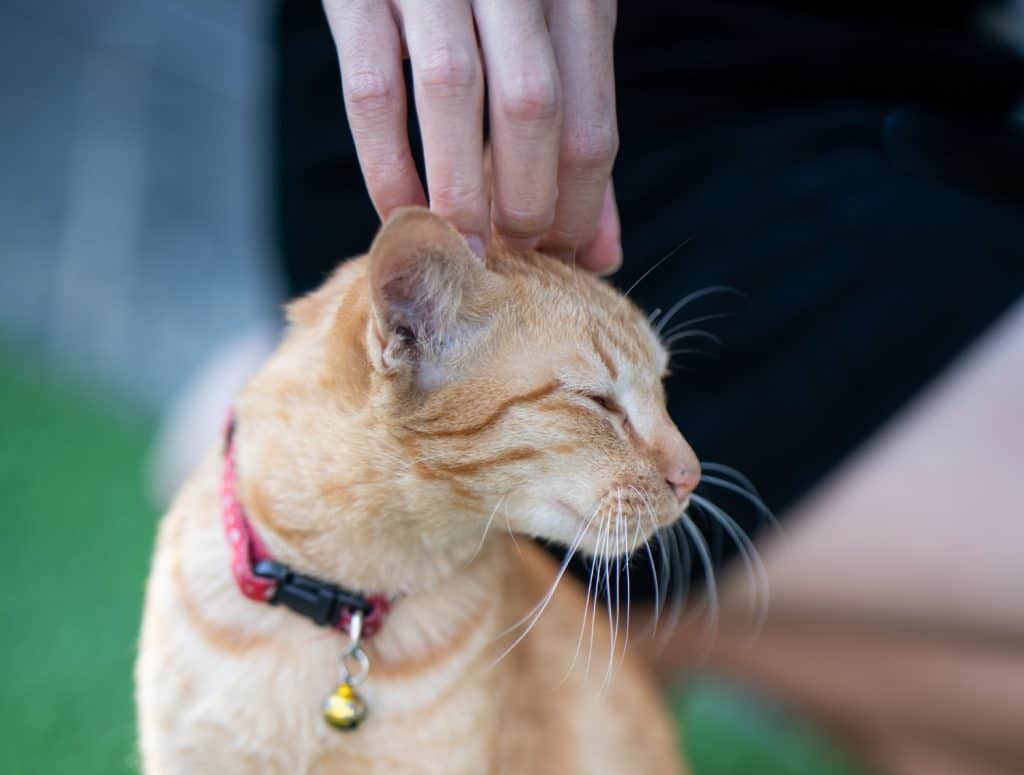
Flea collars are another route you can go down. They’re like a little accessory for your cat but with the bonus of flea protection. Just pop one on your cat, and you’re set for a few months. Plus, they’ve come a long way regarding safety and effectiveness, so they’re definitely worth considering.
And let’s not forget about environmental control. Sometimes, tackling the problem at its source means less stress for your cat and fewer fleas to deal with. Regular vacuuming, washing your cat’s bedding, and using flea sprays in your home can make a big difference.
When should you give your cat a flea bath?
Picking the perfect moment for a flea bath can feel a bit like trying to nail the timing for that perfect cup of coffee in the morning—not too early, not too late, just right.
For our feline friends, timing really is everything when it comes to introducing them to the concept of a bath, especially one aimed at getting rid of those pesky fleas.
So, when is this magical moment? Well, it’s all about catching your cat at their most chill. Have you ever noticed those moments when your cat is in a state of blissful relaxation, perhaps after a hearty meal or a satisfying play session? That’s your golden ticket.
Cats tend to be more mellow during these times, making them more receptive to new and potentially less-than-thrilling experiences, like a flea bath.
Morning or evening doesn’t matter as much as your cat’s personal routine. Every cat has its own rhythm, and getting in tune with that can make a world of difference.
For some, the calm after breakfast might be the ideal time, while for others, the sleepy time right before bed could be the sweet spot. We personally prefer to bathe Feliciano around 7 or 8 pm, right before sleep.
Here’s a little pro tip: integrating grooming practices into your routine can also help set the stage for a successful flea bath.
Brushing your cat, wiping them down with a damp cloth, or even just gently playing with their paws can get them used to being handled. This way, when it’s time for a bath, it’s not such a foreign concept to them.
Creating a Calm Environment
Creating a calm environment for any task involving our furry little friends, especially something as potentially dramatic as a flea bath. It’s all about dialing down the stress and upping the vibes of tranquility.
How can you make the bathing area soothing for your cat?
Transforming the bathing area into a soothing sanctuary for your cat is like setting up a mini spa day for them—think of it as the feline equivalent of a relaxing retreat.

It’s all about making the space feel safe, serene, and as welcoming as possible. You want your cat to step into the bath area and think, “Okay, this isn’t so bad”, rather than plotting their dramatic escape.
First things first, temperature plays a huge role. Just like Goldilocks, we’re aiming for that “just right” vibe. The room should be warm, but not hot; cozy enough that your cat doesn’t feel a chill the moment they’re wet.
A drafty or cold room can be a quick way to ramp up anxiety levels, so maybe crank up the heater a bit or close any windows to keep the warmth in.
Here comes familiarity. Bringing in a favorite toy or blanket (one you don’t mind getting a bit damp) can add a sense of security and comfort. It’s like having a piece of home in this new, potentially daunting environment. This familiar scent can be incredibly calming for cats, providing a reassuring touchstone amidst bathtime activities.
I didn’t do this step, but I did give Feliciano a lot of treats during our first bathing experience. Now, 2 years later, he’s only calm in the shower if I’m the one washing him. While if my husband washes him, he continuously meows.
The setup of the bathing area itself can also make a world of difference. A non-slip mat in the tub or sink is a must to prevent any panic-induced slip-and-slide moments.
Lighting and sound are your secret weapons for a soothing atmosphere. Harsh, bright bathroom lights? No, thank you. Soft, ambient lighting is where it’s at, creating a calm and inviting space.
And don’t underestimate the soothing power of your voice. Speaking in soft, gentle tones can be incredibly reassuring. It’s like being the calming narrator of their spa experience, guiding them through each step with comforting reassurance.
I found that putting the shower head on the floor creates fewer sounds, and doesn’t scare Feliciano as much. Usually, our water pressure is really good, so it makes a lot of sharp sounds for the cat. That’s why I usually fill up a laundry basket with warm soapy water and put Feliciano in it. Then I water him with a pitcher.
Lastly, keep everything you need within arm’s reach—shampoo, cup for rinsing, towel—so you’re not clattering around looking for supplies mid-bath. The less commotion and movement, the better. It’s all about maintaining that tranquil vibe, after all.
What are the steps to safely wet, lather, and rinse your cat?
Bathing your cat, especially for flea treatment, can feel like embarking on a high-stakes adventure. But with the right approach, it can be more of a smooth sail than a turbulent storm. Let’s break down the steps to get your cat safely wet, lathered up, and rinsed off without causing a commotion.
Imagine you’re introducing a baby to a bath—it’s all about gentle and gradual. Start with just a couple of inches of lukewarm water. Cats aren’t fans of surprises, especially of the cold or hot variety, so getting the temperature just right is key. Use a cup or a gentle spray nozzle to slowly wet your cat’s fur, avoiding the head for now. The idea is to ease them into the experience, letting them know there’s nothing to fear.
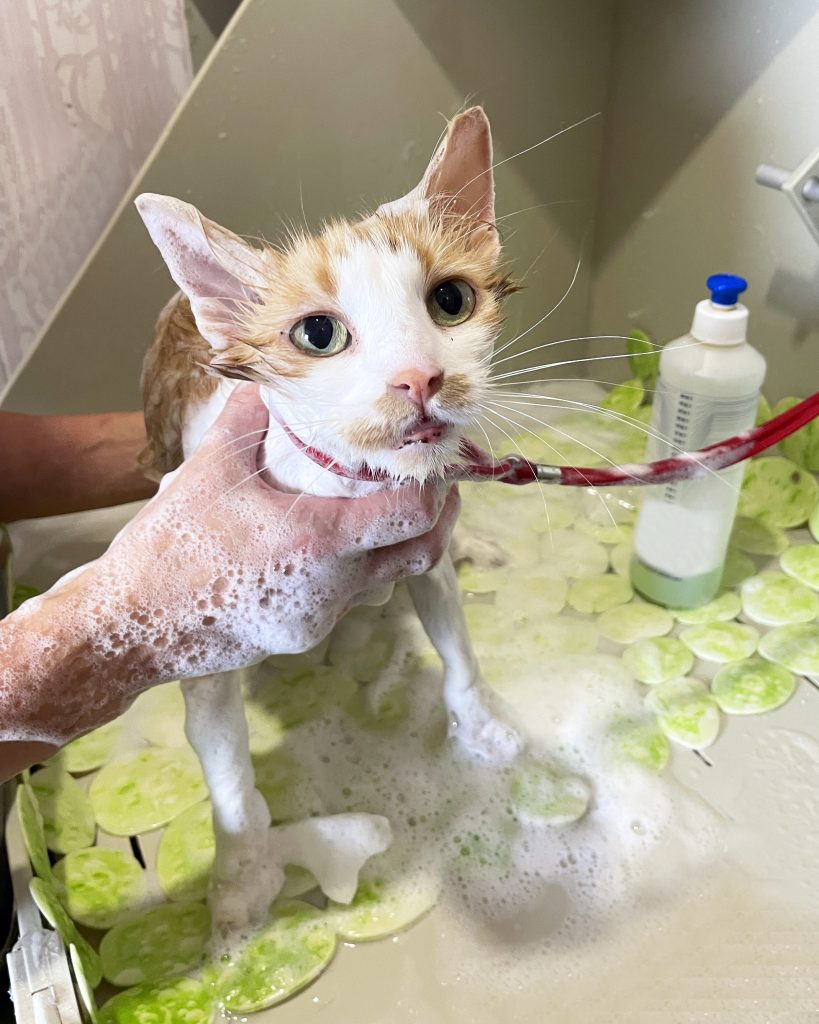
Now, for the lather. Once your cat is wet, it’s time for some flea shampoo action. But remember, less is more. Apply a small amount of cat-approved flea shampoo to your hands and gently work it into a lather on your cat’s fur, massaging it in from neck to tail. This is a bonding moment, so keep the mood light and reassuring. Plus, who doesn’t love a good spa massage, right?
Rinsing is the grand finale and probably the trickiest part. You want to make sure all the shampoo is out to avoid any irritation to your cat’s skin. Go back to your cup or gentle spray nozzle and slowly rinse your cat’s fur, making sure the water runs clear.
Again, keep it lukewarm and soothing. It’s all about patience and ensuring your cat feels secure throughout the process. Make sure to not put water or soap into their ears.
You can gently damp their forehead with your fingers, but make sure to not get water in their ears. Water entering a cat’s ears can potentially lead to irritation, infections, or discomfort.
Throughout each step, keep the vibes positive. Speak to your cat in a calm, soothing tone. Tell them how amazing they’re doing. It’s amazing how much reassurance and a little praise can do to keep a situation calm.
How can you avoid getting water and shampoo in your cat’s ears and eyes?
Navigating a flea bath without turning it into a splash zone for your cat’s ears and eyes is a pain. Let’s face it, getting water or shampoo in those sensitive spots can turn a peaceful bath into a no-go zone pretty quickly.
But with a few tricks up your sleeve, you can keep those ears and eyes serene, ensuring your cat’s bath time is both effective and stress-free.
Think of your approach as more of a precision task rather than a soak-and-rinse. When you’re starting to wet your cat’s fur, do so with the finesse of a tea ceremony—deliberate and gentle. Use a cup or a soft spray nozzle, and begin from the neck down, avoiding the head altogether.
This way, you’re minimizing the risk of any water running into their ears or eyes, which can be uncomfortable and potentially harmful.
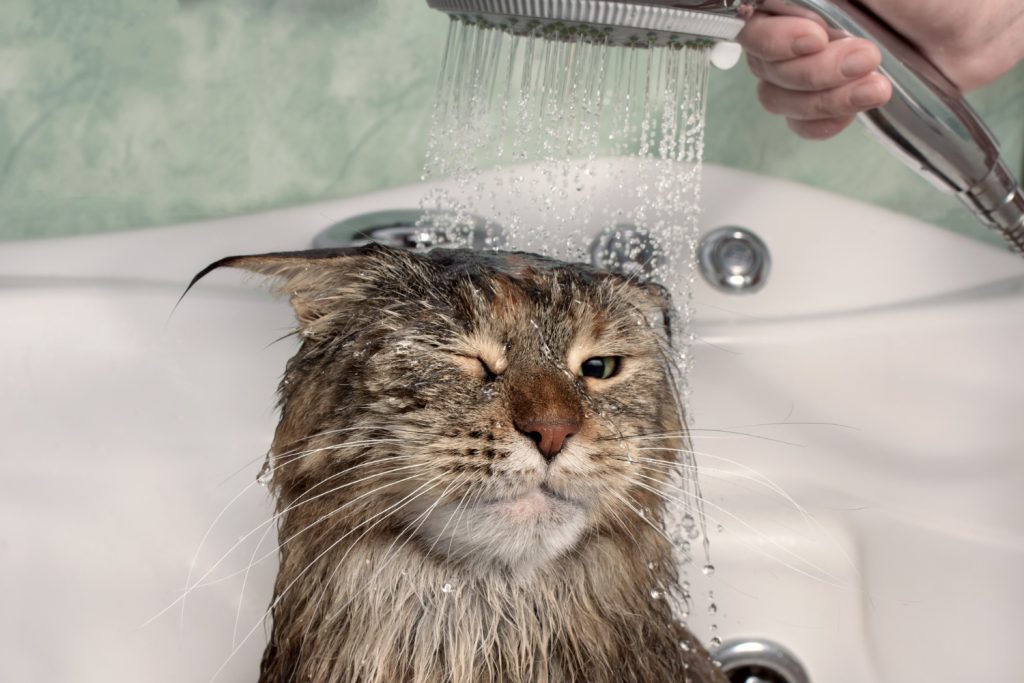
As for the shampoo, apply it with care. Put a small amount of shampoo on your hands and gently massage it into your cat’s fur, steering clear of the face. Or if you’re like me, mix it with the water in a laundry basket.
Think of the head as a no-shampoo zone. If you need to clean around your cat’s face, consider using a damp washcloth instead. This allows you to control where the moisture goes, ensuring you avoid the ears and eyes while still tackling any dirt or fleas trying to hide out in those regions.
Rinsing requires a steady hand and a calm demeanor. Continue avoiding the head, focusing your rinsing efforts from the neck down. If you’ve used a washcloth on the face, a clean, slightly damp one can be used to gently wipe away any suds near the head, keeping those sensitive areas safe.
Throughout the process, keep chatting to your cat in a soft, soothing voice. This not only helps keep them calm but also distracts them a bit from what’s happening. It’s like telling a toddler a story during a haircut—it just makes everything go smoother.
Post-Bath Care
Ah, post-bath care, the time when you and your cat can breathe a sigh of relief. It’s not just about getting through the bath, though; it’s about how you wrap it up that really counts. Let’s talk about the cozy, comforting steps you can take to ensure your cat feels loved and pampered after their spa (flea bath) session.
What are the best techniques for drying your cat after a bath?
Drying your cat after a bath is an art form in itself, one that balances efficiency with your cat’s comfort and tolerance for post-bath shenanigans. It’s like a cozy cuddle session that also serves a practical purpose. Here are the best techniques to turn drying time into a bonding experience for you and your fluffy friend.
The towel wrap is your first move. Wrap your cat up in a soft, absorbent towel like a little burrito. It’s not just adorable; it’s effective. The towel helps absorb a lot of the water right off the bat, reducing the drying time and keeping your cat warm.
Gentle patting and rubbing through the towel can help get more water out of their fur, but remember, the key word here is “gentle”. No vigorous towel drying as you might do for yourself — we’re aiming for calm and soothing, not a full-on workout.

Now, for some cats, the towel might be as far as they’re willing to go, and that’s perfectly fine. Air drying in a warm, draft-free room can do the trick. It’s the low-stress option, especially for cats who view the hairdryer with suspicion.
Set up a cozy spot away from drafts where they can relax and gradually dry off. A sunny window ledge or a warm corner with their favorite blanket can make the perfect drying station.
However, if your cat is one of the rare zen masters who don’t mind the sound and feel of a hairdryer, using one on the lowest, coolest setting can be a game-changer.
Hold the dryer a good distance away to avoid any discomfort and keep a close eye on their reaction. The moment they seem distressed, it’s time to switch back to air drying. The goal here is to make drying as stress-free as possible, not to expedite the process at the cost of your cat’s comfort.
How can you keep your cat warm and comfortable post-bath?
It’s all about ensuring they feel safe, secure, and, most importantly, toasty, as they transition from their aquatic adventure back to being a dry, happy kitty. Here are some cozy tips to make sure your feline friend stays warm and comfortable post-bath.
Think about the perfect warm spot in your home. Cats love warmth (you’ve seen them bask in that sunny window spot, right?), so finding a cozy, draft-free area for them to relax in after their bath is key. It could be a sunny room, near a radiator (but not too close), or even a special spot with a soft blanket just for them.
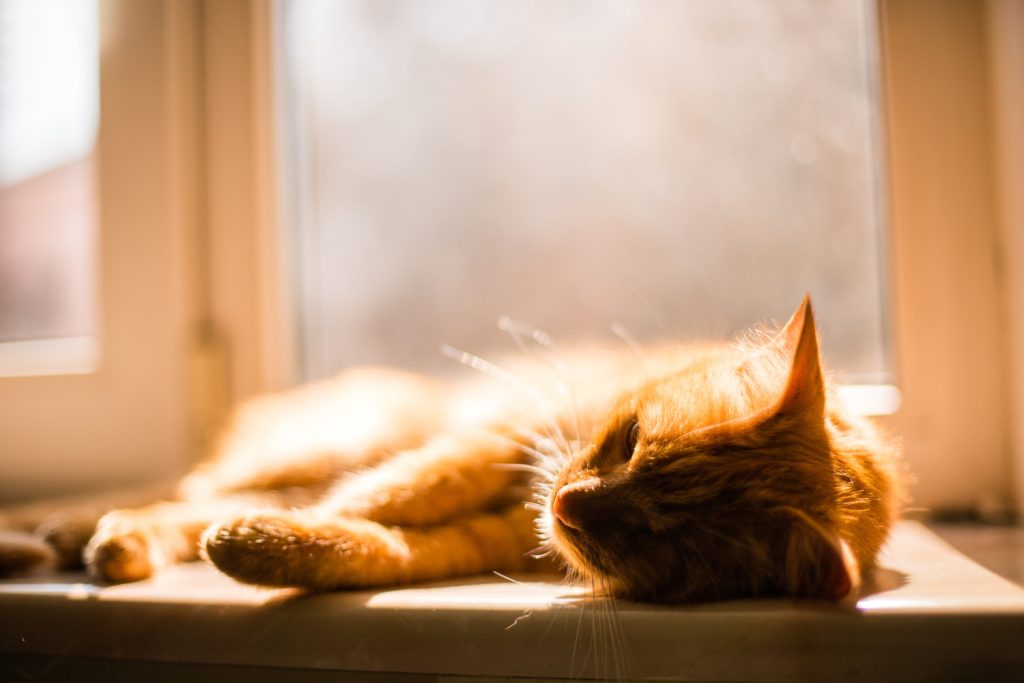
Having a soft, warm towel ready to envelop your cat as soon as they step out of the bath is crucial. Gently pat and rub them down, absorbing as much water as you can. This initial drying is more than just practical, it’s a bonding moment between you and your cat.
Consider adding an extra layer of comfort with a cat bed or a blanket in their favorite hangout area. Cats, being the connoisseurs of comfort that they are, will appreciate a soft, warm place to curl up and continue drying off. Plus, it gives them a sense of security and belonging, knowing they have a special spot just for them.
And remember, post-bath time is also prime for some quiet bonding. Stay close, offer some gentle pets, or a calming chat. It reassures them that they’re safe and loved, and it can help ease any remaining stress from the bath. Plus, it’s a great way for both of you to unwind and enjoy peaceful, quality time together.
Aftercare and Flea Prevention
You’ve already navigated the epic journey of bath time, and now it’s about keeping those pesky fleas at bay for the long haul. Let’s chat about how you can maintain your cat’s flea-free status and ensure they stay as happy and healthy as possible.
Think of flea prevention as a regular part of your cat-care routine. Just like feeding them their favorite treats or giving them those much-loved chin scratches, keeping fleas away is all about consistent care.
There are a ton of options out there, from spot-on treatments that you apply to the back of their neck to oral medications that work like a treat (literally). And let’s not forget about flea collars – they’re like the stylish accessory your cat never knew they needed, but with the bonus of keeping fleas away.
But it’s not just about treating your cat; you’ve got to think about their environment, too. Regularly vacuuming your home, washing your cat’s bedding, and even treating your carpets and furniture with flea-preventative sprays can make a huge difference.
Now, remember, consistency is key. Fleas are tough tiny creatures who don’t give up easily. Keeping up with regular treatments, even when you don’t see any signs of fleas, is crucial. By staying one step ahead, you’re not just protecting your cat; you’re also saving yourself from the hassle of dealing with another infestation.

And let’s talk about the great outdoors. If your cat is an adventurer, exploring the great beyond (aka your backyard), consider adding some natural deterrents to your garden, like certain plants that repel fleas.
Last but not least, keep an eye on your cat for any signs of fleas or discomfort. Regular grooming sessions are a great opportunity to check for any unwanted hitchhikers. And it’s a chance to notice any changes in their skin or coat that might need attention.







